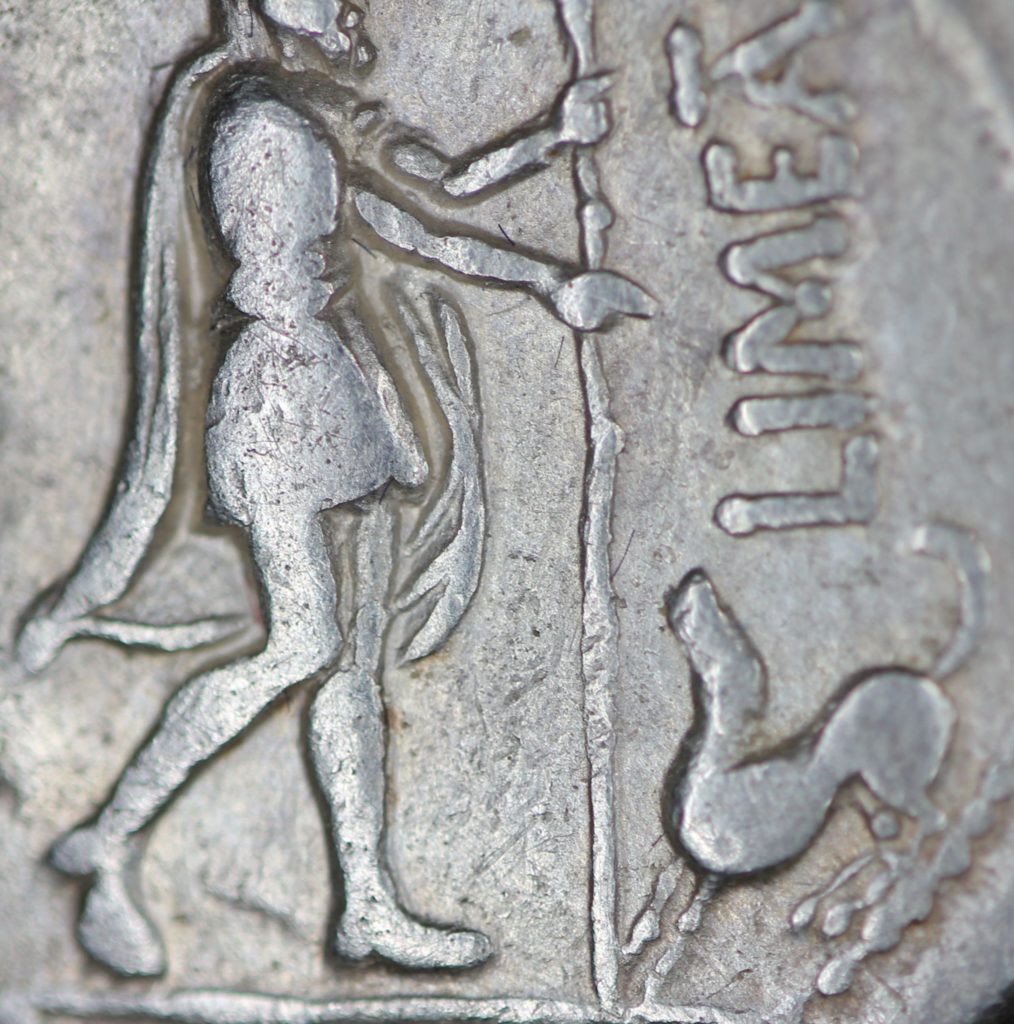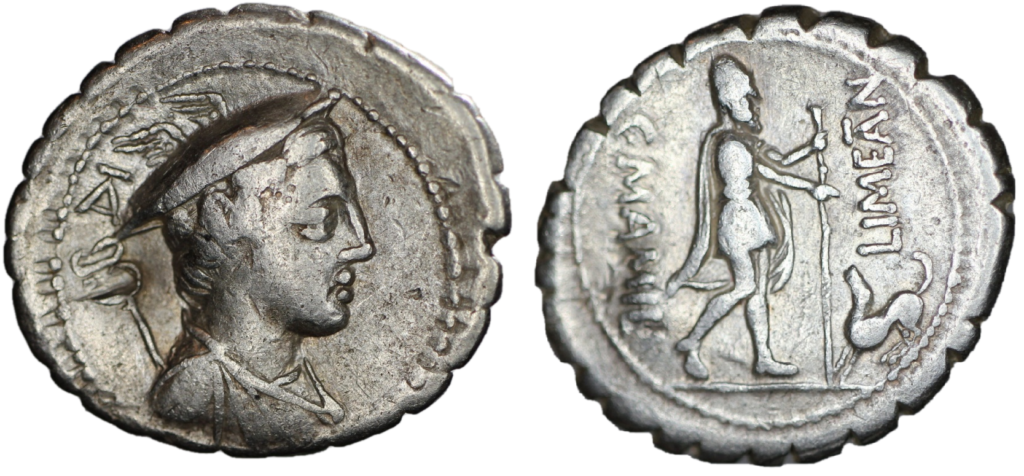This coin, which has one of the most intriguing images of any ancient coin, shows the god Mercury (/ Hermes) on one side, and the returning Odysseus (/ Ulysses) being greeted by his faithful dog Argus, who sees through his disguise to recognise his long-lost master. It was issued in 82BC by Gaius Mamilius Limetanus, who had a father of the same name (as the writing on the reverse shows). It is a serrate denarius, a silver coin cut to bear teeth like a cog, as an anti-forgery technique.
The obverse side of the coin shows a bust of the god Mercury (aka Hermes), facing right. He is wearing a tunic-like garment, and carrying a caduceus (a herald’s wand) over his shoulder, while wearing a natty sun-hat called a petasos, but a fancy one which has the added advantage of wings. These always seemed to me a very impractical place for wings, since I feel strongly that being propelled by the head would make for an uncomfortable journey, if not a perilous one – but Hermes seemed to get on fine with it and I suppose gods are hardier than I am.
The reverse is the side that everyone finds most interesting. It has Odysseus, hero of the Odyssey (aka Ulysses), advancing right while holding a staff. The staff suggests he is travelling, and humbly at that. The soft floppy felt hat is a pilos and Odysseus is often seen wearing one (they have other symbolism but that doesn’t seem pertinent here). He’s gesturing outwards, trying to calm his dog Argos, who poises with palpable excitement at the point of recognising his master. The story comes from Homer Odyssey 17.
Odysseus has returned to his kingdom, Ithaca, but is in disguise so he can take stock of the situation and plan his retaking of his palace from the pesky suitors who are trying to marry his wife. Only his dog, Argus, sees through his disguise. Since Odysseus has been away not only fighting the Trojan war but also having a series of adventures on the way back (incidentally engaging in some infanticide between the two), his dog is necessarily rather old and decrepit, and has taken to lying on the dung heap (presumably it was warm). He is infested with fleas. Nevertheless, spotting Odysseus, he wags his tail, flattens his ears, but has not the energy to get up and go to him. Instead he can only lie. The humans depart again from him,
Ἄργον δ᾽ αὖ κατὰ μοῖρ᾽ ἔλαβεν μέλανος θανάτοιο,
αὐτίκ᾽ ἰδόντ᾽ Ὀδυσῆα ἐεικοστῷ ἐνιαυτῷ.
But the destiny of black Death took away Argos
Immediately he had seen Odysseus, in his twentieth year.

Yet look again at the coin. Odysseus is not gleefully embracing his faithful hound, but looking over the top of him, past him, and trying to settle him down. This makes perfect sense: Odysseus was in disguise at this point (part of what makes it so touching is that his dog recognises him despite the disguise); he’s trying not to let his dog give the game away. Here, the artist has mollified the rather upsetting imagery of the dying flea-bag on a dung-heap, replacing it with the more palatable image of the happy dog. The dog on the coin could hardly look further from keeling over in decrepitude. In what is a lovely touch, he has his rear paws excitedly resting upon the curve of the dotted border – I love these games die artists have played with ignoring and imposing the image’s boundaries (see a comparable case here).
It is, perhaps, the most moving passage of the Odyssey. Odysseus wipes away a tear, and it is easy to empathise. It’s particularly powerful that the emotional link we feel from this imagery is achieved through a relationship with an animal. A palpable, humanising link with people from so long ago.
John Ruskin famously censured Odysseus for giving “not a word of kindness nor regret” to his dog, but others nearer Ruskin’s day pointed out what Odysseus does give, a furtive and potentially self-endangering tear. At any rate, Ruskin’s sentiment about the Homer passage – that it is a deeply upsetting scene – cannot be argued with; but while our coin reminds us of the event, it does so without the distressing emotional overtones.
The control mark
Behind Mercury’s hat is to be found a control mark (these are a letter, numeral, or a little image which were used by the mint as methods of distinguishing different issues or dies). If we put enough of these coins together, the control letters would spell out C LIMETANUS C F, for Gaius Limetanus, son of Gaius. The “TA” of “Limetanus” are sometimes separate letters or, as here, a combination of the T and A together (a ligature). How fortunate that this coin has the most exciting of the control marks! Crawford (1966) 22, in an article some years before his famous book, calls this a “piece of vanity”, but it seems a relatively subtle piece of self-aggrandisement in comparison with claiming descent from an immortal, which seems to be the message behind the presence of Mercury.
The family heritage
Limetanus belonged to the Mamilia family, or gens. They were relatively illustrious; his father (also called Gaius Mamilius Limetanus) had been a tribunus plebis in 109 BC and were at least famous enough to have attracted the envy of someone who wrote a curse tablet naming them (for which see Heurgon 1960).
As Caesar traced his ancestry back to the goddess Venus, so the Mamilia family traced their descent from Hermes, through a slightly convoluted route which runs as follows…
Mamilia, after whom their family or gens was named, was the daughter of Telegonus (and an unnamed woman). Telegonus was the son which Odysseus (aka Ulysses) fathered by the sexy sorceress Circe while on his way home to Ithaka, and his loving wife and growing son (and after a spot of infanticide at Troy, but that’s another story).
Odysseus’ parents were Laertes and Antikleia, and Antikleia’s father was Autolycus, whose father was Hermes. (You might find Antikleia translated online as “without fame”; this is not accurate). So, to summarise, the links with the divine and the moneyer are as follows…
C. Mamilius Limetanus — [A number of generations…] — Mamilia — Telegonus — Odysseus — Antikleia — Autolycus — Hermes.
There’s other paths to divine ancestry when you start including Homeric characters, though. Circe was the daughter of the sun-god Helios. Why did the issuer of the coin choose to emphasise the links with Hermes rather than Helios? Most likely to me seems that he wished to be linked with the god of commerce, which would seem sensible given his position. Perhaps links with the sun-god might also have been a bit far.
There is another interpretation, held for example by Luce (1968) 39, whereby the returning Odysseus is not just a comment on the family’s descent but stands for an event in the contemporary political situation: the return of Sulla to Italy. Crawford (1974) 377 is entirely unconvinced, and though the idea has some appeal, I think Crawford’s scepticism is right.
Crawford, M. H. (1966) “Control-Marks and the Organization of the Roman Republican Mint”, British School at Rome 34, 18-23.
Crawford, M. H. (1974) Roman republican Coinage, Cambridge.
Heurgon, J. (1960) “C. Mamilius Limetanus à Caere”, Latomus 19:2, 221-9.
Luce, T. J. (1968) “Political Propaganda on Roman Republican Coins: Circa 92-82 B. C”, American Journal of Archaeology, 72:1, 25-39.
